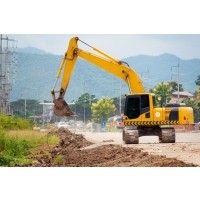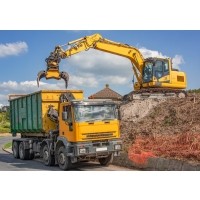Unlocking the Potential: How Hydrostatic Transmissions Revolutionize Komatsu Forklifts
Introduction
Hydrostatic transmissions are a game-changer in the realm of forklifts and material handling. Unlike traditional mechanical transmissions, hydrostatic systems use hydraulic fluid to transmit power, allowing for smooth and precise control over the machine's movements. This technology is particularly significant in applications requiring variable speed and direction changes, making it an ideal choice for forklifts.
Komatsu stands out as a leading brand in the forklift industry, consistently integrating advanced technologies to enhance their machinery. The company's focus on hydrostatic transmissions sets its forklifts apart in terms of performance and efficiency.
Benefits of Hydrostatic Transmissions
- 1. Enhanced Performance: Hydrostatic transmissions provide seamless power transfer, resulting in smoother operation and quicker response times.
- 2. Improved Efficiency: These systems are known for their energy efficiency, reducing fuel consumption and lowering operational costs.
- 3. Precision Control: Operators can achieve more accurate load positioning, minimizing the risk of product damage.
For those interested in exploring cutting-edge forklift technology, Komatsu's range equipped with hydrostatic transmissions offers an excellent starting point.
Understanding Hydrostatic Transmissions
Definition and Key Components
A hydrostatic transmission uses hydraulic fluid to transfer power and consists of the following main parts:
- Hydraulic Pump: Converts mechanical energy into hydraulic energy.
- Hydraulic Motor: Converts hydraulic energy back into mechanical energy.
- Variable Displacement Pumps/Motors: Allow for adjustable flow and speed control.
Working Principle
Hydrostatic transmissions work by using a variable displacement pump to increase the pressure of hydraulic fluid, which then drives a motor. The process involves:
- Pump Action: The hydraulic pump generates flow by converting mechanical input from the engine.
- Fluid Movement: Pressurized hydraulic fluid moves through the system.
- Motor Drive: The hydraulic motor receives the fluid, converting it back into mechanical output.
This smooth transfer of power enables precise control over speed and torque, which is important for tasks that involve moving materials.
Comparison with Conventional Transmissions
When compared to conventional transmission systems, hydrostatic transmissions offer several advantages:
- Seamless Power Transfer: Eliminates the need for clutch mechanisms, providing smooth acceleration and deceleration.
- Enhanced Control: Offers variable speed control without gear shifting.
- Efficiency: Reduces wear and tear on mechanical components, extending equipment life.
Understanding these fundamental differences reveals why hydrostatic technology is increasingly preferred in modern forklifts.
The Versatility of Hydrostatic Transmissions in Forklifts and Material Handling Equipment
Hydrostatic transmissions are incredibly versatile in forklifts and material handling equipment. These systems can be used in different types of forklifts, including:
Warehouse Forklifts In indoor spaces, hydrostatic transmissions provide precise control and quick directional changes, making it easier to maneuver in tight areas.
Rough Terrain Forklifts For outdoor environments with uneven surfaces, the adaptable power delivery of hydrostatic transmissions ensures smooth operation, reducing the strain on the machine.
The versatility of hydrostatic transmissions also extends to specialized material handling tasks. Here are some examples:
- Heavy Load Handling: By providing consistent torque, these transmissions enable steady lifting and positioning of heavy materials without compromising safety or efficiency.
- High-Speed Operations: Hydrostatic transmissions allow for faster movement of loads over long distances, which is essential in large warehouses or distribution centers.
These real-life examples demonstrate just how diverse this technology can be:
- A leading construction company experienced a 20% increase in productivity after switching to hydrostatic forklifts for their site operations.
- Similarly, a major warehouse chain saw a significant reduction in maintenance costs thanks to the seamless power transfer capabilities of hydrostatic systems.
With their ability to adapt to various situations, hydrostatic transmissions have become an invaluable tool across different material handling scenarios.
Benefits of Hydrostatic Transmissions in Komatsu Forklifts
Komatsu is a top manufacturer known for using advanced transmission systems to improve their forklifts' performance. One of the key features they incorporate is hydrostatic transmissions, which offer several advantages:
- Enhanced Productivity
- Hydrostatic transmissions allow for smooth direction changes and quick acceleration, leading to faster work cycles.
- With reduced lag time in response, operators can navigate through tasks more efficiently.
- Precise Control
- The use of hydrostatic transmissions enables operators to have better control over load positioning, ensuring accuracy during lifting and placing operations.
- The smooth operation provided by this system also minimizes jerky movements, reducing the chances of product damage.
- Prioritizing Operator Safety
- Speed control mechanisms are integrated into the hydrostatic transmissions of Komatsu forklifts, allowing operators to maintain safe speeds in different working conditions.
- Additionally, these forklifts feature ergonomic design elements such as comfortable seating and optimal visibility, creating a safer working environment for operators.
By incorporating these innovative features into their forklifts, Komatsu demonstrates their commitment to utilizing state-of-the-art technology to deliver machines that excel in performance, safety, and operational efficiency.
Reliability and Durability: The Long-Term Advantage of Komatsu Forklifts with Hydrostatic Transmissions
Incorporating hydrostatic transmissions in Komatsu forklifts significantly enhances their reliability and durability. Unlike conventional transmission systems, hydrostatic technology minimizes mechanical wear and tear, leading to reduced maintenance costs and downtime.
Key Factors Contributing to Reliability and Durability:
- Reduced Component Wear: Hydrostatic transmissions rely on hydraulic fluid to transfer power, which eliminates the need for clutches and gearboxes. This results in fewer mechanical parts that can fail, extending the lifespan of the forklift.
- Consistent Performance: The seamless power transfer provided by hydrostatic systems ensures consistent performance even under heavy loads. This stability contributes to a longer operational life for the equipment.
Several Komatsu forklift owners have reported positive experiences regarding longevity. One testimonial highlights that a fleet of Komatsu forklifts with hydrostatic transmissions operated efficiently for over 10 years with minimal maintenance interventions. Another case study reveals a significant reduction in operational disruptions due to the robust nature of these transmissions.
These real-world examples illustrate how hydrostatic transmissions not only boost performance but also offer long-term reliability, making them a sound investment for any material handling operation.
Conclusion
Hydrostatic transmissions have significantly improved the performance and safety standards in forklifts and material handling operations. These advanced systems allow for smooth direction changes, quick acceleration, and precise load positioning, resulting in unmatched productivity and operator safety with Komatsu forklifts.
Discover the wide range of Komatsu forklift models equipped with this state-of-the-art technology to fully maximize their capabilities in your industry. Implementing hydrostatic transmissions can bring about:
- Improved efficiency
- Reduced downtime
- Increased overall reliability
The future of hydrostatic transmissions looks promising as they continue to evolve and reshape the world of material handling equipment. This ongoing development will push the limits of what forklifts can accomplish in different operational settings.
Stay ahead in this ever-changing industry by embracing this technology and its benefits. For more information and to explore the latest models, visit cppbrand.com.
FAQs (Frequently Asked Questions)
-
What are hydrostatic transmissions and why are they significant in forklifts and material handling?
Hydrostatic transmissions are a type of transmission system that uses hydraulic fluid to transfer power. In forklifts and material handling equipment, they play a crucial role in providing seamless power transfer, precise control, and enhanced efficiency.
-
What is the focus on Komatsu forklifts as a leading brand in the industry?
Komatsu is recognized as a leading brand in the forklift industry due to its commitment to leveraging advanced transmission systems, such as hydrostatic transmissions, to enhance the performance, safety, and versatility of their forklift models.
-
How do hydrostatic transmissions work and what are their key components?
Hydrostatic transmissions work by using hydraulic fluid to transfer power from the engine to the wheels or other mechanical components. Key components include variable displacement pumps/motors and a hydraulic fluid reservoir.
-
How can hydrostatic transmissions be optimized for different types of forklifts and material handling tasks?
Hydrostatic transmissions can be optimized for various types of forklifts, such as warehouse or rough terrain models, as well as specialized material handling tasks by adjusting the hydraulic flow and pressure to meet specific operational requirements.
-
What benefits do hydrostatic transmissions offer in Komatsu forklifts?
In Komatsu forklifts, hydrostatic transmissions enable enhanced productivity through seamless direction changes and swift acceleration, precise control for load positioning, and prioritized operator safety with integrated speed control mechanisms and ergonomic design elements.
-
How do hydrostatic transmissions contribute to the reliability and durability of Komatsu forklifts?
The use of hydrostatic transmissions in Komatsu forklifts contributes to overall reliability and durability by reducing maintenance costs and downtime. This technology has been proven to enhance the longevity of Komatsu forklifts according to relevant case studies and customer testimonials.
-
What is the impact of hydrostatic transmissions on the evolving landscape of material handling equipment?
Hydrostatic transmissions have a transformative impact on enhancing both performance and safety standards in material handling operations. They play a pivotal role in shaping the future of material handling equipment by unlocking their full potential in various industries.
By promoting Komatsu's innovative use of hydrostatic transmissions, you can significantly enhance the visibility and appeal of their forklifts within the industry. For more information on Komatsu parts and accessories, visit cppbrand.com.





